
St James railway station is a heritage-listed underground commuter rail station that is located on the City Circle, at the northern end of Hyde Park in the Sydney central business district of New South Wales, Australia. It is served by Sydney Trains T2 Inner West & Leppington, T3 Bankstown & T8 Airport & South line services. It is named after the nearby St James' Church and provides a direct link to the Sydney Airport international and domestic railway stations. It was added to the New South Wales State Heritage Register on 2 April 1999.
Air traffic control in Australia is provided by two independent organisations, one civilian and one military. The civilian provider is Airservices Australia, which controls civilian airfields and airspace. The military provider is the Royal Australian Air Force (RAAF), which controls military airfields and adjoining airspace. This includes Australian Army and Royal Australian Navy aviation bases. Some airfields in Australia are categorised as Joint User airfields, where there are both civilian and military operations based at the airfield. Normally, Joint User airfields have air traffic control provided by the RAAF.

RAAF Base Rathmines is a heritage-listed former RAAF Second World War seaplane base and now used as community venues, sports venues and a visitor attraction at Dorrington Road, Rathmines, City of Lake Macquarie, New South Wales, Australia. It was in use as an RAAF base from 1939 to 1961. It is also known as Rathmines Park, former RAAF Seaplane Base, Flying Boat Base, Rathmines Aerodrome and Catalina Base. The property is owned by Australian Christadelphian Bible School, Disability Life Enrichment, Don Geddes Nursing Home and Lake Macquarie City Council. The remains of the former air base was added to the New South Wales State Heritage Register on 25 November 2005.

Evans Head Memorial Aerodrome is a heritage-listed airport in Evans Head, Richmond Valley Council, New South Wales. The airport is approximately 1 km (0.62 mi) north of the village. During World War II it was Royal Australian Air Force (RAAF) Station Evans Head supporting RAAF No 1 Bombing and Gunnery School (1BAGS) and subsequently the RAAF No 1 Air Observers School. At the height of operations there were three asphalt runways and one grass strip. Only a single asphalt strip is still in use by private aviation. It was added to the New South Wales State Heritage Register on 22 November 2002.
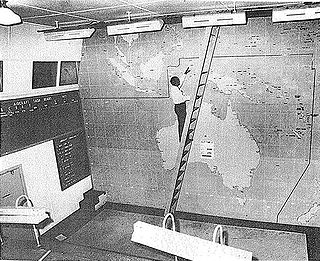
Bankstown Bunker, formerly known as Air Defence Headquarters Sydney, is a heritage-listed defunct Royal Australian Air Force (RAAF) operations facility, located on the corner of Marion and Edgar Street, in Condell Park, City of Canterbury-Bankstown, New South Wales, Australia. It was designed by Allied Works Council and built from 1943 to 1944 by Stuart Bros Pty Ltd of Sydney. It is also known as Air Defence Headquarters Ruin Sydney (former), No. 1 Fighter Section Headquarters, 1FSHQ, Bankstown Bunker and RAAF No. 1 Installation Bankstown; No. 101 Fighter Sector. It was added to the New South Wales State Heritage Register on 18 November 2011.
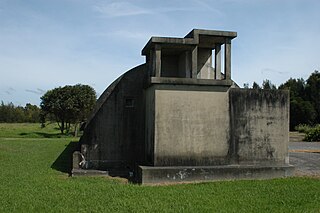
No. 131 Radar Station RAAF is a heritage-listed former Royal Australian Air Force radar station at Kooragang, City of Newcastle, New South Wales, Australia. They are also known as the Radar Igloo and Radar Buildings. They now operate as the Estuarine Interpretive Centre.
RAAF Bradfield Park was a Royal Australian Air Force (RAAF) station located at the former suburb of Bradfield Park, New South Wales during World War II.

Breddan Aerodrome is a heritage-listed abandoned aerodrome at Gregory Developmental Road, Breddan, Charters Towers Region, Queensland, Australia. It is located 15 kilometres (9.3 mi) north of Charters Towers. It was built from 1942 to 1943 by Allied Works Council and Queensland Main Roads Commission. The airfield was constructed for the USAAF 38th Bomb Group in August 1942 as a satellite field for Charters Towers Airport, and later used by the Royal Australian Air Force (RAAF) during World War II as a maintenance base. Consisting of two runways, the airfield was abandoned after 1948. Today, the remains of the airfield consist of some deteriorating runways, taxiways and hardstands, mostly being reclaimed by grassland and shrub. No buildings have survived. It is also known as Breddan Airfield and Breddan WWII Aircraft Maintenance, Repair and Salvage Depot. It was added to the Queensland Heritage Register on 16 April 2010.
No. 19 Radar Station RAAF was a Royal Australian Air Force radar station formed at Bombi near Bouddi, New South Wales, Australia on 15 April 1942.
No. 17 Radar Station RAAF was a Royal Australian Air Force radar station formed at Burrewarra Point, Guerilla Bay, New South Wales, Australia on 12 April 1943. The radar became operational on 29 April 1943 after initial training and setting up the radar equipment.
No. 18 Radar Station RAAF was a Royal Australian Air Force (RAAF) radar station formed at Richmond, New South Wales, Australia on 1 April 1942.
No. 20 Radar Station RAAF was a Royal Australian Air Force radar station formed at Nelson Bay, New South Wales, Australia, during World War II on 12 April 1942. The radar station was set up upon Tomaree Head, Port Stephens and became operational on 1 June 1942.

Clare Grant Stevenson, AM, MBE was the inaugural Director of the Women's Auxiliary Australian Air Force (WAAAF), from May 1941 to March 1946. As such, she was described in 2001 as "the most significant woman in the history of the Air Force". Formed as a branch of the Royal Australian Air Force (RAAF) in March 1941, the WAAAF was the first and largest uniformed women's service in Australia during World War II, numbering more than 18,000 members by late 1944 and making up over thirty per cent of RAAF ground staff.

No. 227 Radar Station RAAF was a Royal Australian Air Force radar station located at Yanchep, Western Australia. Established during World War II to provide early warning of Japanese air raids against Perth, the radar station was formed in 1942–43 and operational by late 1943.

Charlie's Hill Radar Station is a heritage-listed radar station off Charlie's Hill Road, Inkerman, Shire of Burdekin, Queensland, Australia. It was built in 1943 by Royal Australian Air Force. It was added to the Queensland Heritage Register on 23 February 2001.

Operations and Signals Bunker is a heritage-listed signal station off Stuart Drive, Wulguru, City of Townsville, Queensland, Australia. It was built from 1942 to 1944. It is also known as James Cook University, RAAF No.3 Fighter Sector Headquarters (3FSHQ), and Stuart Immigration Hostel. It was added to the Queensland Heritage Register on 28 August 1998.
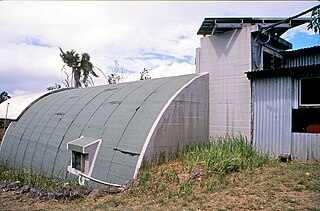
Bones Knob Radar Station is a heritage-listed radar station at Bowcock Road, Tolga, Tablelands Region, Queensland, Australia. It was built in 1943. It is also known as WWII RAAF 220 Radar Station. It was added to the Queensland Heritage Register on 14 May 2010.
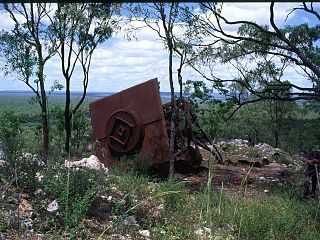
Radar Hill is a heritage-listed radar station at Gulf Developmental Road, Mount Surprise, Shire of Etheridge, Queensland, Australia. It was built about August 1943 by the Allied Works Council. It is also known as No. 53 RDF Station. It was added to the Queensland Heritage Register on 12 July 2005.
The Tomaree Head Fortifications is a heritage-listed fortification at 2 Shoal Bay Road, Shoal Bay, New South Wales, Australia. It is also known as Tomaree Head Battery, Tomaree Battery and Stephens Battery. It was added to the New South Wales State Heritage Register on 22 October 2010.
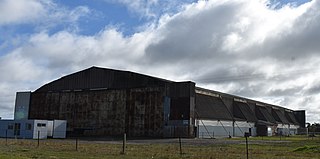
World War II Aeroplane Hangar, Tocumwal is a heritage-listed former Royal Australian Air Force (RAAF) aircraft hangar at Tocumwal, in Berrigan Shire, New South Wales, Australia. The hangar was constructed in 1942 by the Allied Works Council as part of the construction of RAAF Station Tocumwal. The hangar was added to the New South Wales State Heritage Register on 25 July 2021.














